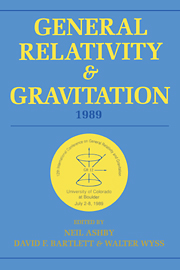 General Relativity and Gravitation, 1989
General Relativity and Gravitation, 1989 Book contents
- Frontmatter
- Contents
- Preface
- Conference committees
- Part A Classical relativity and gravitation theory
- WORKSHOPS
- Part B Relativistic astrophysics, early universe, and classical cosmology
- 5 Gravitational lenses: theory and interpretation
- 6 Recent observations of gravitational lenses
- 7 Inflation and quantum cosmology
- 8 Theory and implications of cosmic microwave background Radiation
- 9 The cosmic microwave background: present status of observations, and implications for general relativity
- WORKSHOPS
- Part C Experimental gravitation and gravitational wave detection
- WORKSHOPS
- Part D Quantum gravity, superstrings, quantum cosmology
- WORKSHOPS
- Part E Overviews-past, present, and future
6 - Recent observations of gravitational lenses
Published online by Cambridge University Press: 05 March 2012
- Frontmatter
- Contents
- Preface
- Conference committees
- Part A Classical relativity and gravitation theory
- WORKSHOPS
- Part B Relativistic astrophysics, early universe, and classical cosmology
- 5 Gravitational lenses: theory and interpretation
- 6 Recent observations of gravitational lenses
- 7 Inflation and quantum cosmology
- 8 Theory and implications of cosmic microwave background Radiation
- 9 The cosmic microwave background: present status of observations, and implications for general relativity
- WORKSHOPS
- Part C Experimental gravitation and gravitational wave detection
- WORKSHOPS
- Part D Quantum gravity, superstrings, quantum cosmology
- WORKSHOPS
- Part E Overviews-past, present, and future
Summary
Introduction
During the last two years a burst of results has come from radio and optical surveys of “galaxy lenses” (where the main deflector is a galaxy). Even if this kind of work were better known and had already been reviewed for this assembly a few years ago, I cannot pass up the main results which have presently emerged. This will be the first part of the presentation.
On the other hand, in September 1985 we pointed out a very strange blue ring-like structure on a Charge-Coupled Device (CCD) image of the cluster of galaxies Abell 370 (Soucail et al. (1987a)). After ups and downs and a persistent observational quest, this turned out to be the Einstein arcs discovery (Soucail et al. (1988); Lynds and Petrosian (1989)), an important observational step in this particular field since the first observation of the double Quasi-Stellar Object (QSO) 0957 + 561 in 1979 (Walsh et al. (1979)).
Following this discovery, new observational results have shown that many rich clusters of galaxies can produce numerous arclets: tangen-tially distorted images of an extremely faint galaxy population probably located at redshift larger than 1 (Fort et al. (1989); Tyson (1989)). This new class of gravitational lenses proves to be an important observational topic (Mellier (1989a); Fort (1989a)). This story will be the second part of this presentation.
The classification between galaxy lenses and cluster lenses is somewhat arbitrary.
- Type
- Chapter
- Information
- General Relativity and Gravitation, 1989Proceedings of the 12th International Conference on General Relativity and Gravitation, pp. 153 - 176Publisher: Cambridge University PressPrint publication year: 1990
